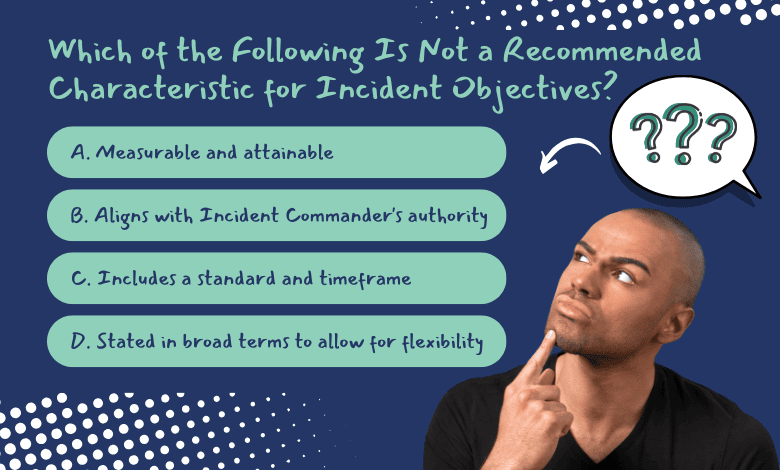Which of the Following Is Not a Recommended Characteristic for Incident Objectives?

When managing emergencies or incidents, having clear and effective objectives is crucial for a successful response. Incident objectives guide decision-making, resource allocation, and overall strategy—but which of the following is not a recommended characteristic for incident objectives? Not all characteristics are equally beneficial; some can actually hinder effectiveness.
Question: Which of the following is not a recommended characteristic for incident objectives?
A. Measurable and attainable
B. In accordance with the Incident Commander’s authorities
C. Includes a standard and timeframe
D. Stated in broad terms to allow for flexibility
Correct Answer: D. Stated in broad terms to allow for flexibility
Why Is This the Right Answer?
Incident objectives must be precise, actionable, and outcome-driven—not open-ended. Here’s why:
| Recommended Characteristics | Why They Matter | What Happens If Missing? |
| Measurable & attainable (A) | Ensures progress can be tracked and goals are realistic. | Unrealistic goals lead to wasted effort or failure. |
| In accordance with the Incident Commander’s authorities (B) | Keeps actions legally and organizationally sound. | Overstepping authority can cause legal/operational issues. |
| Includes standards & timeframe (C) | Sets clear expectations for success. | Lack of deadlines slows response; no standards mean unclear success metrics. |
| Stated in broad terms (D) ✘ | Seems flexible but creates confusion. | Teams misinterpret priorities; resources are misallocated. |
Why Are Well-Defined Incident Objectives Important?
- Clarity: Ensures all responders understand priorities.
- Accountability: Helps measure success and adjust strategies.
- Efficiency: Prevents wasted effort on unclear goals.
How to Write Effective Incident Objectives
Based on FEMA’s ICS (Incident Command System) guidelines, strong objectives should follow the SMART criteria:
- Specific – Not: “Reduce the fire.” Instead: “Contain 50% of the northern flank by dusk.”
- Measurable – Use percentages, timeframes, or tangible outcomes.
- Achievable – Align with available resources and conditions.
- Relevant – Directly tied to life safety, property, or environmental priorities.
- Time-bound – “Within 4 hours” or “by 2200 hours tonight.”
Bad vs. Good Objective Examples
| ❌ Poor Objective | ✅ Improved Version |
| “Help affected residents.” | “Set up a shelter for 200 displaced persons at Maple High School by 2000 hours.” |
| “Control the spill.” | “Deploy absorbent booms to contain 90% of the chemical spill upstream by 1200 hours.” |
Top 10 FAQs About Incident Objectives
1. What are incident objectives?
Incident objectives are clear, actionable goals set by the Incident Commander to guide emergency response efforts.
2. Why shouldn’t incident objectives be too broad?
Broad objectives create ambiguity, making it harder for teams to take decisive action.
3. Who sets incident objectives?
The Incident Commander (IC) or Unified Command team establishes them based on the situation.
4. How often should incident objectives be updated?
They should be reviewed and adjusted as needed—often during operational briefings or when conditions change.
5. What makes an incident objective “measurable”?
It should include specific metrics (e.g., “contain 80% of the wildfire within 6 hours”).
6. Can incident objectives conflict with the Incident Commander’s authority?
No—objectives must always align with the IC’s legal and organizational limits.
7. What happens if objectives lack a timeframe?
Without deadlines, teams may delay actions, reducing response effectiveness.
8. Are incident objectives the same for every emergency?
No—they vary based on the incident type (fire, flood, hazmat, etc.) and severity.
9. How do incident objectives relate to the Incident Action Plan (IAP)?
Objectives are a key part of the IAP, which outlines strategies and tactics.
10. What’s the biggest mistake in setting incident objectives?
Being too vague—this leads to miscommunication and inefficient resource use.
Final Thoughts
When evaluating “Which of the Following Is Not a Recommended Characteristic for Incident Objectives?“, remember that effective objectives are specific, measurable, and time-bound—not broad or flexible. This clarity ensures a coordinated response, ultimately improving safety and outcomes.
Would you like additional insights on incident management best practices? Let us know in the comments!



